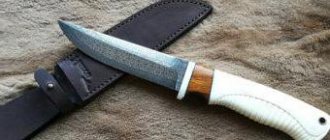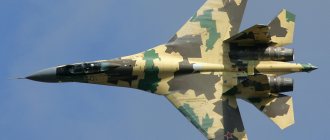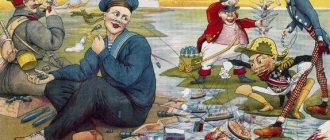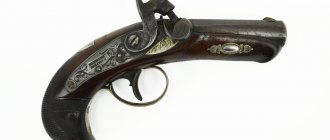Swords
| This section is missing references to information sources. Information must be verifiable, otherwise it may be questioned and deleted. You may edit this article to include links to authoritative sources. This mark was set on March 31, 2013 . |
swords in the Viking Museum in Hedeby.
Judging by archaeological studies of Scandinavian burials of the 9th-10th centuries, swords were the most common weapon. However, most likely, they were simply preserved more carefully; at that time, axes, for example, were used as working tools.
The phrase “Scandinavian sword of the Viking Age” most often refers to a two-edged blade made of crucible steel with a fuller in the center, a handle for one hand and a characteristic pommel. Indeed, three quarters of the swords are double-edged, but the remaining quarter is single-edged - that is, it has a one-sided sharpening and looks like a very long skramasax, which is equipped with a guard and a pommel of one or another type characteristic of Scandinavia. The length of blades of both types was most often 77-80 centimeters. The width at the top of the blade varies from 5 to 6 centimeters. The handle is short - the distance between the guard and the pommel is from 8.5 to 10.5 centimeters - most often 9 or 9.5. The mass of the blade is about a kilogram[1].
Swords were partly brought from neighboring countries, in particular from the Frankish Kingdom. This is evidenced by the marks of Frankish weapon workshops on blades; the most famous are the marks of the workshop of Ulfberht, which were often counterfeited. A considerable part was made in Scandinavia itself, where craftsmen often copied and developed imported samples.
Single-edged swords were used in the first half of the Viking Age, at most until the 10th century - later only double-edged ones were found. If you believe Petersen's research, the quality of imported Frankish swords was much higher than similar Scandinavian ones - the carbon content in the steel of Norwegian swords is significantly lower [1].
Compared to later European bladed weapons, which weighed 3 kilograms, the Viking Age sword was relatively light (on average 1.2-1.5 kg). However, due to the design features of the handle and blade, it was difficult in practice to deliver any blows other than chopping. There is no reliable information - descriptions or images - that show exactly how they fought with these weapons. Information from Icelandic family sagas on this matter is rather superficial and contradictory. One can only assume that the sword was most often used with the right hand, paired with a round wooden shield in a fist grip. The blow of the sword was most likely received on the shield, preferably on the metal umbon of the latter, while one’s own sword was used to strike back. Blows in this combination are most effective when applied to the head or legs, for which there was practically no protective equipment in the Viking Age.
In “The Saga of Gisli, Son of Sour,” the main character kills his opponent in a duel, splitting the latter’s skull, but also breaking his valuable sword. In the Egil's Saga and the Battle of the Wasteland Saga, sudden sword strikes are mentioned that cut off the opponent's legs.
Especially valuable swords were sometimes given personal names. The Egil's Saga describes the Viking preparations for the Battle of Brunanburg (937):
“Thorolf had the following weapons: a large and thick shield, a strong helmet on his head, and a sword at his belt. He called this sword Long. It was a nice weapon. Thorolf held a spear in his hand. The tip of the spear was two cubits long and had a tetrahedral point on top. The top of the tip was wide and the sleeve was long and thick. The shaft was so long that standing you could reach the socket with your hand. It was very thick and bound with iron. An iron spike fastened the sleeve to the shaft. Such spears were called “stakes in armor.” Egil armed himself in the same way as Thorolf. At his belt hung a sword, which he called Echidna. Egil obtained it in Courland. It was an excellent weapon..."
[2]
Further, when describing the battle itself, the saga twice mentions that when delivering slashing blows, the sword could be held with both hands. There was probably a technique of fighting with two swords. In the same “Saga of Egil”, in particular, it says: “Egil prepared for battle with Ljot. He had a shield that he usually used. On his belt he had a sword, which he called Echidna, and in his hand he held the sword Dragvandil ... "
[3]
Estoc
A well-known variant of a purely piercing weapon is the estok. At first glance, it resembles the shape of a knight's sword, but only at first glance. This larger weapon, often capable of two-handed use, is technically more of a sword-shaped spear. Estok, in principle, does not have a blade sharpening, but its edge is excellent. Unlike most of the weapons listed in the article, the estok is not a cutting-and-piercing sword at all.
This weapon was used to work against men-at-arms, who are completely unaffected by chopping blows with a sword. The technique is simple: we fencing as with an ordinary sword, then we grab our blade by the middle with our free hand and drive the tip into the armpit, eye socket or other weakly protected place of the armor. In modern modeling, no one is interested in estoks, since it is not entirely clear how one can fence with them correctly and at the same time safely.
It is sometimes believed that the rapier originated from the estoc. Now, this is not true. Estok, once again, is a special weapon for fighting against men-at-arms on the battlefield. The rapier is intended for duels with an unarmored enemy, mainly in peacetime.
Axes
Main article: Scandinavian battle ax
According to, for example, Norwegian archaeologists, for every 1,500 finds of swords in Viking Age burials, there are 1,200 axes, and often an ax and a sword lay together in the same burial. It is often quite difficult to distinguish a working ax from a combat axe, but a Viking Age battle ax is usually smaller in size and somewhat lighter than a working one. The butt of the battle ax is much smaller, and the blade itself is much narrower. Most battle axes were presumably used with one hand.
At a later time, in the 11th centuries, massive so-called “Danish axes” - with crescent edges, a blade width of up to 45 cm, called “brodex” (bredøkse) or “bridex” - from breið öx (carpenter’s axe).
Scandinavian sagas, in addition to the usual axe, also mention atgeir
and
kesja
- a type of combined polearm, similar to a halberd, possibly of imported origin[4][5].
Shamshir, talwar and other curved sabers
In the Middle East, curved swords were and continue to be popular. There are quite a few varieties of medieval curved sabers; they differ in size, balance, weight, and so on. But the whole point of their designs, the general characteristic of which is a curved blade with sharpening on the outside, comes down precisely to excellent cutting blows.
The outer curvature allows less of the blade's cutting edge to make contact with the target upon impact, which increases pressure and therefore cuts better. In addition, with the correct grip, the continuation of a technically correct (for a curved sword, of course) blow leads to the fact that the saber itself seems to cut the target, sliding along it from the outside. You can also cut with a straight blade, but this movement is less natural.
Of course, the curved geometry of the blade complicates conventional injections, but does not completely eliminate them.
Indian talwars (and not only them, but especially them) have the same short handle as the Carolingians. The disc-shaped apple also holds the hand securely, like the crossbar of a Viking sword. Other curved sabers, on the contrary, have a longer handle, suitable for a more modern saber grip. I would like to note that the rigid hammer grip does not make the talvars any kind of primitive and inconvenient swords; with such a grip they cut at least no worse, and thrusts were obviously considered unprincipled.
Perhaps the most striking representatives of this family of swords are shamshira-scimitars. These are, respectively, Persian and Arabic names for a saber with a blade shaped like a crescent. Obviously, such curved swords cut just fine, but it is inconvenient to stab with them, although it is possible, but not in a straight line, but from the side. The closest relative of shamshirs and scimitars is the Turkish kilic, which is distinguished by a slightly heavier end.
Knives (Saxons)
Saxons in the Viking Museum in Hedeby
Main article: Saxon (knife)
The sax is a long, single-edged knife that was usually carried by honorary citizens in Norwegian society. The longer version was called skramasaks. In peacetime, it was something like a machete, but it was also a formidable weapon in close combat. The rich man owned a larger knife, slightly smaller in size than the sword.
Bone Age of Africa
The Stone Age in Africa is remarkable for one thing. In addition to stone tools, people knew how to make tools from bone. In 2012, archaeologists discovered a knife-shaped artifact off the coast of Morocco. The quality suggested that the craft of bone dressing had reached a high level around 90,000 years ago. Before this discovery, it was believed that bone-carved tools were used for “simple” everyday tasks. However, in this case it turned out to be a special knife. Analysis showed that it was used to cut something soft, most likely leather. Scientists believe the bone knife was made by members of the Aterian culture, a society that lived 145,000 years ago. The ancient master took the rib of an animal the size of a cow and cut it lengthwise. One half was turned into an artifact 13 centimeters long. This find cast doubt on the idea that the production of improved tools (to support survival) occurred much later.
Spears
Spears are the most common type of weapon. The northern spear had a shaft about five feet (about 1.5 m) long with a long, wide, leaf-shaped tip. Such a spear could both stab and chop.
In the “Saga of Egil”, when describing the Battle of Brunanburg, it says, in particular:
“Thorolf was so furious that he threw his shield behind his back and took the spear with both hands. He rushed forward and hacked and stabbed enemies left and right. People ran away from him in different directions, but he managed to kill many. So he cleared his way to the banner of Earl Hring, and no one could resist him. He killed the warrior who carried the banner of Earl Hring and cut the flagpole. Then he thrust the spear into the earl’s chest, so that it passed through the armor and body and came out between the shoulder blades ... "
[6]
According to other sources, this spear was also called a “horn.” The shafts were made mainly from ash, bound with iron so that the shaft could not be cut. Such a spear weighed a lot, so throwing it was not easy.
There were also special throwing spears, similar to European darts and sulits. Such spears were shorter, with a narrower tip. Often a metal ring was attached to them, indicating the center of gravity and helping the warrior to give the throw the right direction.
Tao and Jian
A huge number of Chinese Tao swords are, one way or another, akin to falchions. Some of them look more like cleavers, others like pointed ones, but the essence is the same. I would like to emphasize that daos look more like falchions than Middle Eastern sabers. Two-handed variants do not change the matter; this is the same evolution of the falchion as the appearance of a long sword based on a knight's sword.
Tao swords for the most part are not that heavy, since their wide blades usually have a fairly small thickness. Of course, there were exceptions, especially the famous dadao, which Chinese soldiers used to break the swords of Japanese officers in the 30s of the 20th century. Often there were variants of pole weapons, when a blade typical of a Tao sword was mounted on a long shaft like a Japanese naginata.
Jian is a Chinese double-edged cutting and stabbing sword. The differences between actual surviving examples and examples of similar European weapons are minimal. Jian fits perfectly into the line of knight's sword - Carolingian - spatha. Maybe only thinner on average, and the handle. Modern objects called jian swords and used in wu-shu are almost as little related to military weapons as a sports rapier is to a combat weapon or a bamboo shinai is to a normal steel Japanese sword.
Interestingly, by the end of the 3rd century AD, variants of the Dao sword had completely replaced Jian swords from the battlefield. The Jian became a weapon for aristocrats to defend themselves in times of peace. In Europe, a similar niche appeared about 1300 years later. After moving into the category of civilian weapons, the jian gradually began to become lighter, and if not for the weak hilt, it could be compared with very late short swords.
In China, of course, there was a lot of exotic stuff, including bladed weapons - take the same jian gou, hook swords, but... it doesn’t make a difference. Almost all of this exotic appeared during the Qing Dynasty, in the 17th century and later, and it was exclusively a civilian weapon. That is, there were some enthusiasts and even schools of enthusiasts who studied such cunning contraptions and found charm in them. Sort of fencing hipsters.
And so, with real swords, everything is the same as in Europe. Only there is less variety when we talk about real military weapons, and not about all the sharp toys at once.
Literature
- Zharkov S.V.
Vikings. The first illustrated encyclopedia. - M.: Eksmo, 2018. - 752 pp.: ill. — Series “The Best Warriors in History.” — ISBN 978-5-04-090373-3. - Oakeshott Ewart.
Weapons and military armor of Europe. From ancient times to the end of the Middle Ages. - M.: ZAO "Tsentrpoligraf", 2009. - 704 p. — ISBN 978-5-9524-4069-2, 9785952440692. - Petersen Jan.
Norwegian Viking Age swords. Typochronological study of weapons of the Viking Age. - St. Petersburg: Alpharet, 2005. - 352 pp.: ill. — ISBN 5-902882-06-0. - Heath I.
Vikings. Story. Armament. Tactics. - M.: LLC "AST", Astrel 2004. - 64 p.: ill. — Series “Elite Troops”. - Tsepkov A.I.
Viking armament in the 9th–11th centuries. According to the Icelandic sagas and the “Earthly Circle”. - Ryazan: Alexandria, 2013. - 320 p. - Chartrand R., Duram K., Harrison M.
Vikings. Sailors, pirates, warriors. - M.: Eksmo, 2008. - 192 p. — Series “Military History of Humanity.” — ISBN 978-5-699-23504-9, 9785699235049.
- Ewart Oakeshott: The Sword in the Age of Chivalry
, 1994, ISBN 978-0851153629 - Alan R. Williams, Methods of Manufacture of Swords in Medieval Europe: Illustrated by the Metallography of Some Examples,
Gladius 13 (1977), pp. 75 - 101. - M. Müller-Wille: Ein neues ULFBERHT-Schwert aus Hamburg.
Verbreitung, Formenkunde und Herkunft , Offa 27, 1970, 65-91 - Ian Peirce: Swords of the Viking Age
. The Boydell Press, 2002, ISBN 978-0851159140 - Anne Stalsberg “The Vlfberht Sword Blades Re-evaluated”
- Alan Williams “A Metallurgical Study of Some Viking Swords”
Poison Ring
The killer's accessories are rarely mentioned in the archaeological record. In 2018, excavations in Bulgaria uncovered a ring that likely killed several people. It was found in the medieval ruins of Cape Kaliakra, home to the 14th-century elite of Dobruja. Other jewelry was also found in Kaliakra, but these were ordinary jewelry made of gold and pearls. The bronze ring was 600 years old, beautifully made, and probably came from Spain or Italy. There was a cavity inside from which poison could be quietly poured into the victim's drink. Since the ring was made for the little finger of a man's right hand, the killer was right-handed (the cavity was also located on the right). Archaeologists suspect that the ring could be connected to an old medieval riddle. In the 14th century, a Bulgarian feudal lord named Dobrotitsa ruled the region. The story tells of many unexplained deaths in his circle, especially among the aristocrats and nobles. These deaths were likely political assassinations.
Ötzi's Arrows
Ötzi's arrows.
Years after its discovery in the Italian Alps, Ötzi's "ice mummy" is now considered one of the most studied mummies in the world. Everything from his health to his genes was tested. But for some reason, his toolkit hasn't received the same scrutiny. In 2020, the tool and weapon set was re-scanned. The 5,300-year-old "treasure" has provided interesting clues to the ongoing debate about what happened to the man. He was undoubtedly killed by a skillfully crafted arrow. It remains unclear whether he was expecting an enemy. Researchers found that a few days before his death, Ötzi sharpened some of his tools, but he did not touch the weapons, apparently believing that he was safe. Who killed this man so far in the Alps remains a mystery.
Thames Mallet
The Stone Age was cruel. Many of the turtles showed signs of the preferred method of killing at that time - breaking the head. In 2017, researchers tried to determine what weapons were used to do this. The idea was to find something that was only used by humans and could not act as a hunting tool. The so-called “Thames Beater” fits these conditions perfectly. A 5,500-year-old wooden artifact resembling a cricket bat has been pulled from the River Thames.
The researchers made an exact replica of the weapon and tested it on artificial human skulls, complete with skin, bone and brain. The results were stunning - the wounds closely matched Neolithic injuries. The clumsy paddle-shaped club from the Thames proved deadly. It was most likely made to serve solely as a device for killing people.
Source






